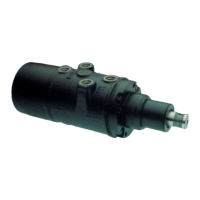Bulletin 2751-001-M1/USA
Service Manual
HGA Hydraguide™
Hydraulics
Parker Hannifin Corporation
Hydraulic Pump/Motor Division
Greeneville, Tennessee
9
Hydraguide™ Steering
POWER STEERING OPERATION
When the spool is in center or neutral position, the
hydraulic oil from the engine-driven pump circulates
through the valve section, directly back to the reservoir
with sufficient pressure only to overcome friction of
valve channels and lines. There is no circulation of
engine-driven pump oil to or from the cylinder. Note
the center diagram showing neutral position (See
diagram on inside front cover) on which no directional
arrows appear in the metering channels. The oil
pressure at the two cylinder ports is equal and pro-
duces ineffective forces in the cylinder.
In order to accomplish a power steering maneuver, the
operator must rotate the steering wheel in the direc-
tion of the steering maneuver. The initial rotation of the
steering wheel rotates the input shaft which tends to
rotate the drive link and rotor set through the torsion
bar centering spring. Rotation of the rotor set and
spool which are coupled by the drive link, is resisted
by the cylinder pressure required to overcome the
steering forces. As the input shaft is rotated relative to
the spool, the centering spring is torsionally deflected.
Axial shift of the spool is induced by the ball which is
captive in the spool and engaged in the helical groove
provided in the input shaft.
When the spool is axially displaced within the body,
fluid channels are selected connecting the engine-
driven pump to the intake side of the rotor set via the
WARNING: ALL STEERING MECHANISMS ARE LIFE AND LIMB ITEMS. AS SUCH, IT IS IMPERATIVE
THAT THE INSTRUCTIONS IN THIS BOOKLET ARE FOLLOWED TO THE LETTER. FAILURE TO OB-
SERVE THE PROCEDURES SET OUT IN THIS PAMPHLET MAY RESULT IN LOSS OF STEERING.
commutator. The exhaust side of the rotor set is
connected, through the commutator, to one side of the
cylinder while the other side of the cylinder is con-
nected to the reservoir. (See Figures HGA-1 and 2).
Further axial displacement of the spool results in
increased system pressure to provide the level of
pressure required. A portion or all of the hydraulic fluid
at the required pressure from the engine-driven pump,
depending upon the speed of steering, is directed to
the cylinder via the metering section, using cylinder
movement to accomplish the steering maneuver.
MANUAL STEERING OPERATION
In the absence of system pressure, the driver's
manual effort displaces the spool axially. When the
spool is displaced within the body, fluid channels are
selected connecting the rotor set, which is now acting
as a pump, via the commutator to one side of the
cylinder. The return flow from the other side of the
cylinder is channeled through a recirculation valve so
that the oil will flow to the intake side of the rotor set
via the commutator instead of back to the reservoir.
(See. Figure HGA-5) The recirculation valve is a ball
check valve in a channel connecting the return flow
chamber to the engine-driven pump pressure inlet
chamber. The recirculation valve is closed during
power operation.

